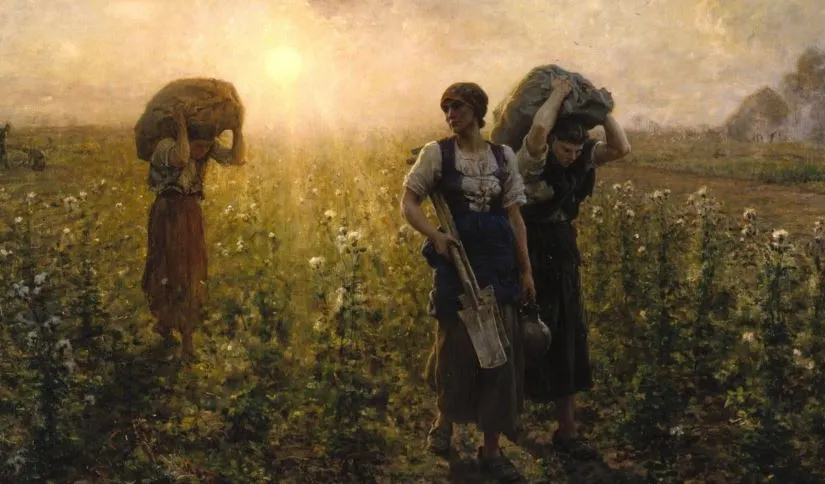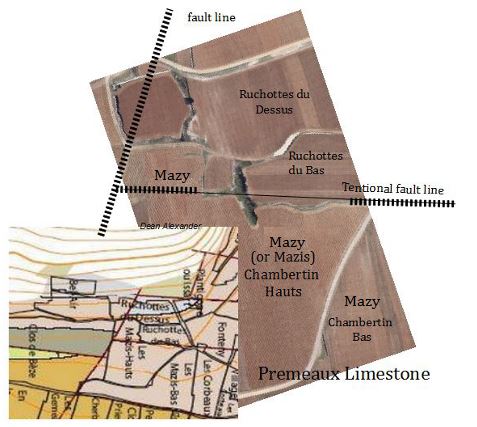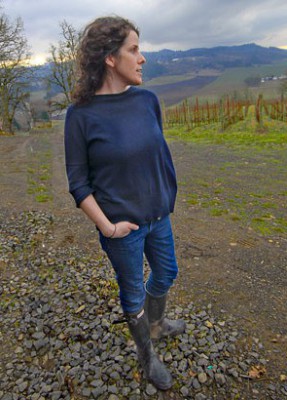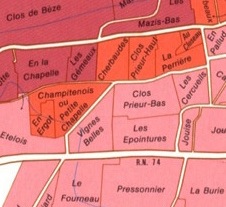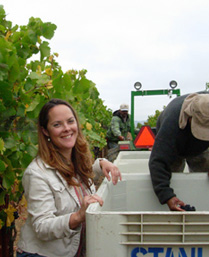The wine villages of the Côte d’Or in the 18th Century
By Dean Alexander
 Reflecting on it, I find it amazing that the descendants of so many old Burgundian families still farm the vineyards, and live in the same tiny villages of the gold coast as their ancestors. Many of these families have lived there for more than two centuries. The Roty’s of Gevrey-Chambertin arrived there in 1710, and have now lived in Gevrey for more than three centuries, and the Mongeard family arrived in Vosne in 1620, just shy of four centuries.
Reflecting on it, I find it amazing that the descendants of so many old Burgundian families still farm the vineyards, and live in the same tiny villages of the gold coast as their ancestors. Many of these families have lived there for more than two centuries. The Roty’s of Gevrey-Chambertin arrived there in 1710, and have now lived in Gevrey for more than three centuries, and the Mongeard family arrived in Vosne in 1620, just shy of four centuries.
Consider further, for many generations, all but the most wealthy, rarely traveled much farther than the fields that they worked, none of which were very far away. They often did not know the families from two or three villages distant, because to get there, many of them would have had to walk. They lived and died in the houses in which they were raised, and that was often the same house that their mother or father was raised.(1) For most urbanites, this is kind of stationary life is unfathomable. But this long history of a family being precisely in a single place, for so many generations, can only be explained by these people having developed exceptionally strong emotional ties to their village, their family, and to their land.
While to outsiders, the daily life of the farmer can only describe as repetitious and mundane, in the long view, the changes that have occurred on the Côte can be fascinating. Over the span of the past two to three hundred years, these fermier families have had, along with a certain amount of luck, the ability to adjust and adapt at crucial times.
First and foremost, they were lucky. To have had built up enough assets to handle disasters as they came can be a matter of luck. Any ship can sink in the perfect storm. But beyond that, they tenacious, yet flexible enough to endure nature’s worst. Examples of adversity the families of the Côte would face included: multiple, several near-total harvest failures, and more than a couple vineyard losses due to vine killing winters, hail, and flooding. Then there were the major diseases such as mildew (oidium in 1854 and downy in 1887) not to mention phylloxera.

The political and economic challenges were relentless, included the lengthy French Revolution, multiple governmental changes, and economic and the catastrophes of wars and occupation. Had these families not been lucky, not had assets when they needed them, and not made the right decisions at the right time, they would have left been forced to leave, as many did. (Garnot 2008) Most importantly, they had the ability to make the jump from being simple paysans, meaning the peasant-farmers, who only just subsisted on small plots land, to fermiers who not only owned the land they worked, and more importantly, owned enough land they needed to hire people to help work the land they owned.
Gone from the Gold Coast now are those paysans. Their small plots absorbed by larger landholders and their labor replaced in the fields professional vineyard managers and workers and supplemented day laborers.
Throughout the late 19th and most of the 20th century, it was an idealized version of these very peasants, who had been economically pushed out of the Gold Coast, by which the French viewed their own national identity. The French viewed itself as the peasant: a stout, strong, determined, rural proletariat, who farmed the land, feed the nation and were called to war. (Lehning 1995) It was generally felt that the peasants were the backbone of the country. As such, it was with a certainly irony, that much later, during the 1920 and 1930’s, the fermiers of the Côte would begin to market Burgundy and themselves as synonymous with the already existent folklore of the ‘peasant farmer’. (Whalen 2009) This would be their guarantee of quality, their simple honesty, steadfastness, and hard work.

The growth of a village
In an isolated locale, like the wine villages of the Côte d’Or, a census is a very good barometer of the health of its economy. As the economy heats up, as financial folks like to say, the population increases. Conversely, as the economy slows, populations tend to contract accordingly. In 1793, toward the end of the Revolutionary period, the first census of the new republic was taken. At this time, the population of Gevrey was only 1,193. Over the next two decades, Gevrey’s population would grow only incrementally until 1831, when it would begin to expand over the next 50 years.
Phylloxera, in its steady march across France, would finally reach the vineyards of the Côte d’Or in 1880. However, rather than the loss of production forcing the population to contract, -as those “in the margins” were indeed displaced by a lack of field work, new inhabitants were arriving, largely replacing their numbers. A whole new industry had sprung up surrounding the fighting of phylloxera. As that battle was gradually lost, these jobs would eventually be replaced by those who would plant the vineyards again. These were people who had trained in the new skills of grafting vinifera Pinot and Chardonnay vines to the hybrid American rootstock. This carousel of workers kept the number of people living in the village fairly constant, but generally, the fermiers, the landholding farmers, many whose family names we recognize today, remained.
The census of 1881 revealed a population of 1,868. Shortly after the turn of the century, economic instability, and low wine prices, and falling vineyard values, would cause the lowest number of inhabitants since the census had begun, with a mere 1,543. Gevrey’s population would fall even further during the interwar years, for in 1936 Gevrey had a population only 1,486, the lowest it had been after one hundred years of growth. These were grim times, and the fermiers and concerned politicians sought new ways to produce and market wine independent of the negociants that had controlled the industry since the 1750’s. These efforts, coupled with the Europe’s general economic recovery after the Second World War, has sent the population dramatically upward, with new industries which supported the now profitable wine growers and bringing with them hundreds of new jobs. The censuses of 1962 and 1975 marked how dynamic the recovery had been. (census figures: fr.wikipedia.org)
 The population of the larger town of Nuits-St-Georges, a center for negociant trade in the mid-1700‘s, has been more stable than Gevrey. Nuits expanded through pre-phylloxera times but then remaining fairly steady for almost a century between 1866 and 1954. The town’s population saw minor fluctuations of alternately adding and losing 100 to 400 people, through the end of the Second World War, but these changes were a much smaller percentage of the population than the swings seen in Gevrey-Chambertin. This is likely that because of the town’s size, there was far more business operating in Nuits-St-Georges beyond the direct cultivation of the vines. As an overview: in 1793 Nuits had 2,541 inhabitants. It peaked just before phylloxera 1881 at 3,727 people. Today, after steady growth since the end World War II, (3,285 in 1946), the population now sits at 5,516 in 2008. (fr.wikipedia.org)
The population of the larger town of Nuits-St-Georges, a center for negociant trade in the mid-1700‘s, has been more stable than Gevrey. Nuits expanded through pre-phylloxera times but then remaining fairly steady for almost a century between 1866 and 1954. The town’s population saw minor fluctuations of alternately adding and losing 100 to 400 people, through the end of the Second World War, but these changes were a much smaller percentage of the population than the swings seen in Gevrey-Chambertin. This is likely that because of the town’s size, there was far more business operating in Nuits-St-Georges beyond the direct cultivation of the vines. As an overview: in 1793 Nuits had 2,541 inhabitants. It peaked just before phylloxera 1881 at 3,727 people. Today, after steady growth since the end World War II, (3,285 in 1946), the population now sits at 5,516 in 2008. (fr.wikipedia.org)
Stepping farther back in time
The old villages, tranquil wine smaller villages of the Côte d’Or, with their narrow streets and quaint houses, are quite easy to envision two hundred fifty years ago, during the time of King Louis the XVI, for these are remain small, sleepy, villages. Vosne even today has a population of a mere 427 people, and only 307 people live in the nearby village of Chambolle. Even with the tourists that mill around and support the restaurants and inns of the old, more touristy section of Gevrey-Chambertin, this section of town could not be described as bustling. It would seem as though place must be quite unchanged over hundreds of years. In your mind’s eye, just exchange the slow trod of oxen pulling a cart along the graveled highway for the cars that now ply the paved RN74. Upon the once cobbled streets of the better sections of the village, add in horses and the staccato of their hooves. Wood-smoke, billowing from the chimneys of a few dozen open hearths; the day crisp, with fall in the air, and the vision should be complete.
But things have changed in these villages. Perhaps the biggest paradigm shift took place when the vines of Pinot Noir won out over Gamay.
(*) larger is relative, but considering the value of the land, and the wine made from it, these are not poor men. (**)The increase of population in the larger towns and villages is best explained by more wealth is created by both vignerons and by the tourist industry, the there are more jobs available to service their needs today.

Economic battle between of Pinot Noir and Gamay
 For many centuries, there was an economic and ideological battle going on between those who were planting the vines that produced the more consistently ripening Gamay grape, and those who would have all vines in Burgundy planted only to Pinot Noir.
For many centuries, there was an economic and ideological battle going on between those who were planting the vines that produced the more consistently ripening Gamay grape, and those who would have all vines in Burgundy planted only to Pinot Noir.
For some, the battle was societal. While certainly it was recognized that Gamay could produce a high-tonnage of fruit, while still maintaining acceptable quality (for the masses), the noblesse d’épée (noble of the sword), the noblesse de robe (magistrates and parliamentarians of Dijon), clergy officials, and most acutely, the invested haut bourgeoisie, felt the Gamay wines were coarse and undeserving vineyards of the Côte d’Or. Most importantly, they rightly felt Gamay pulled down the reputation of the Côte in general. Gamay certainly did not add to the noble reputation that the upper strata of society believed the region should be allowed to attain. Social standing and reputation in the 18th century was hugely important to those in a position to affect it, and cannot be underestimated in the context of where some Gamay should and should not be planted in Burgundy.
For centuries there was a vocal pressure to eliminate Gamay, and although it was banished by Philip the Bold in 1395, peasants continued to grow on the slopes through the end of the 19th century. In Morey, “Of the 160 hectares under vine,” Auguste Luchet wrote in 1858, “90 are planted to Gamay.” Later in the text, he would write: “Gevrey has about four hundred hectares of vineyards, half in Gamay and one in Pinol (Noirien) mixed with a little white.”
According to Marion Fourcade, an associate professor at UC Berkeley, there were “periodic local ordinances” eradicate Gamay in vineyards of the Côte d’Or. In her paper,“The Vile and the Noble” (2012), Fourcade briefly mentions that those who pushed to expunge Gamay alleged its cultivation promoted various unspecified “health dangers”. As an economic problem, Gamay’s critics charged that its cultivation contributed to an increase in the fraudulent bottling of Gamay as Pinot Noir, or alternately, it was accused that Gamay was illegitimately blended with Pinot Noir. This no doubt occurred. But, as previously believe in the preceding centuries, Gamay was, in general, unworthy of the region.
 Dr Jules Lavalle, in his 1855 book, “Histoire et Statistique de la Vigne de Grands Vins de la Côte-d’Or, which was revered by many, calls Gamay “common,” and “ordinary,” claiming Gamay had “invaded hilltops and flatlands all around”. (Forcade 2012) “God knows how awfully active the vulgar plant has been in driving away the fine plant, and what progress it makes every day! Our ancestors would have been appalled!” As translated by Fourcade. In Charles Curtis’s translation of Lavalle (in which I did not find the aforementioned quote) in his book the “Original Grand Crus of Burgundy”, Lavalle writes “The vines planted in Gamay cover more than 23,000 hectares,(1) which one meets under the name of plante Mâlain, plante d’Arcenant, plant de Bévy” Additionally Lavalle condemns that “The yield can often extend to 50 and even 60 hectoliters per hectare.”
Dr Jules Lavalle, in his 1855 book, “Histoire et Statistique de la Vigne de Grands Vins de la Côte-d’Or, which was revered by many, calls Gamay “common,” and “ordinary,” claiming Gamay had “invaded hilltops and flatlands all around”. (Forcade 2012) “God knows how awfully active the vulgar plant has been in driving away the fine plant, and what progress it makes every day! Our ancestors would have been appalled!” As translated by Fourcade. In Charles Curtis’s translation of Lavalle (in which I did not find the aforementioned quote) in his book the “Original Grand Crus of Burgundy”, Lavalle writes “The vines planted in Gamay cover more than 23,000 hectares,(1) which one meets under the name of plante Mâlain, plante d’Arcenant, plant de Bévy” Additionally Lavalle condemns that “The yield can often extend to 50 and even 60 hectoliters per hectare.”
The choice to plant Gamay was surely decided, however, not by the ideological mindset, or by social consciousness, but rather by the wealth of the vigneron. The poor farmer could simply not afford the high-stakes gamble of Pinot Noir presented, with its pitifully small production of 18 hectoliters per hectare (Lavalle 1855), and its inability to consistently ripen its fruit completely The peasant could not afford a single failed vintage, that the high-risk Pinot Noir grapes delivered this result on a fairly consistent basis.*
Moreover, Pinot, with its thin skin was particularly prone to rot and disease, it was far more difficult to make into a competent wine. In some years, Pinot vines would produce a completely unsalable crop. The wealthy landowning farmer (a fermier – as opposed to a vigneron) could take such a gamble with virtual impunity, because when it the Pinot crop paid off, the dividends of producing a great wine, far outstripped the losses incurred by poor to very poor vintages. The incredible demand (and payday) for wines from great vineyards, in these great years, continues to this day.
(*) It is not without note that the little ice-age, (which dates are contested) is generally thought to have begun in the 1300’s, and ended around 1850. Additional weather variations occurred, with extremely low temperatures materializing with disastrous effect in 1660 1709, 1740 and 1794/1795 and the last in the year 1850.

The paysan of the Côte, a poly-cultiveur
While we think of only vines on the slopes of the Côte d’Or, the vineyards of the early to mid 18th century, were typically a polyculture. It was common for the vines to share the slopes with animals, fruit trees, and vegetable plots, depending on the site. (Swann 2003) However, as the 18th century progressed, economics would begin to crowd out polyculture off of the slopes.
Below the vines of the great vineyard slopes, upon low-lying fields, grew all manner of foods, particularly grains. Rye which grew well on the poor soils of northern France, corn, wheat and barley were widely grown; and in personal gardens next to their houses, the peasants often grew vegetables. It is well documented that the lower third of Clos St-Jacques was planted to alfalfa until 1954, but it is likely that it had been home to many different crops over the centuries.
Very few ‘vignerons’ during the 18th century actually worked solely with the vine, and those that did, according to historian Benoit Garnot, were in decline in the 18th century. He laments bleakly that “the tired qualification ‘winemaker’ seems to be socially rewarding.” (Garnot 2008)
Busby wrote, in 1840, that in vignerons in Chambertin would rip out dying provignage vines (which only survived ten years or so), and let the land fallow while being planted to sainfoin, a cover crop that flourishes on calcareous (limestone) soils. Planting sainfoin had dual benefits: it not only would the crop rejuvenated the topsoil with an infusion of nitrogen but it also the sainfoin was a good feed for their grazing animals. Those vignerons that had a cow or two, had them tended by a communal herder who took them to field for the day and returned them to the owner at night.

The fall harvest season was unrelenting and well-reported as being extreme in the exhaustion it created. By the end of August, all of the rye, which was an important crop in the poor soils of north-eastern France, and the summer wheat, had already been harvested. Also already harvested were the other major crops, which included barley, colza, which is also known as rape, or rapeseed, was grown for lubricants, and hemp (not to be confused with its relative cannabis), was also grown for seed, oil, wax, resin, rope, cloth, pulp, paper and, in this north-eastern region. (U.S.Gov. Printing Office 1888) This would give the paysan a month for the grape harvest, before the planting of winter wheat, which would begin straight away in October, after pressing and barreling of the new wine.
Centuries of stagnant agricultural practices
It is widely accepted that during the ancien regime, few improvement in farming had come to France. The tasks of the cultiveur were done in the least expensive manner; just as their fathers and grandfathers, and as well their great-great grandfathers had farmed the same land.
To the English agronomist Arthur Young, who visited Burgundy and elsewhere in France on the eve of the revolution, the inefficiencies of French agriculture was “quite contemptible’. He was so critical of French farming methods as to say that even the large capitalist farms were “villainous cultivated’. As far as investing in capitalization farming given the French methods, he declared “If I had a large tract of this country, I think I should not be long in making a fortune’.(Swan 2003)
Change was painfully slow, despite attempts by Dijon to push the people to adopt them. The problem really came down to money, and the peasants had none to invest in the changes necessary. A Burgundian representative to the National Constituent Assembly, during the first stages of the Revolution, explained the failure of previous attempts at agricultural reform:
“Oh you who complain of the intractability of the peasant when he refuses to adopt your new ploughs, your new seed drills…your deep furrows, your doses of fertilizer that are four times greater than what he can afford, before tripling his expenses in the uncertain hope of a tripled harvest, begin by putting him in a state of being able to buy clogs for his children.”

Up Next: The Villagers of the 18th Century
Additional Notes:
(1) Life was short and death rates of children under the age of ten were high. Because of this, and the general lack of excess money homes traditionally multi-generational. There will be much more about life and death on the Gold Coast in upcoming chapters.
(2) Charles Curtis, in his book “The Original Grand Crus of Burgundy”, takes these hectare figures, printed in Lavalle, at face value, and proceeds to discuss how they might be accurate. However, I feel, that they are as just as likely, a misprint, so far off from the hectares, as they exist today, even taking into consideration the loss of so much vineyard land, post-phylloxera, that was never replanted around Dijon. One might also view these figures to be considered a fabrication, as a call to action against the Gamay scourge. Words are weapons. Because there appears to be no other at the ready figures of Gamay and Pinot Noir acreage planted in the Cote d’Or to compare Lavalle’s figures with, I choose to bypass the issue altogether. It isn’t all that germane enough to the already too wide of a scope of these writings, to deal with something I can’t bring to an adequate conclusion about. There are other fish to fry.
Reference Sources for Burgundy: History of the Vignerons: The Villages parts I – IV
La Côte-d’Or à vol d’oiseau: lettres écrites à M.L. Havin, après la récolte, Auguste Luchet 1858
Gevrey-Chambertin: notice historique, topographique et statistique, suivie de promenade à Fixin, by Henri Vienne 1850
Journal of a Tour through some of the vineyards of Spain and France, James Busby, Sydney 1833
Peasant Proprietors and other selected essays, Lady Frances Parthenope Verney Longmans, Green, 1885 –
L’état de la recherche sur la vigne, le vin et les vignerons en Bourgogne au XVIIIe siècle, Benoit Garnot, 2008
The Peasants and the King in Burgundy, Hilton Root, University of California Press, 1992
Evolution du Métayage en France, L. Durousseau-Dugontie, Impr. Crauffon, 1905
Centre d’Histoire de la Vigne et du Vin, Charlotte Glain-Fromont, Bulletin de liaison Bulletin 30 janv-fev 2012.pdf
LES Climats du vignoble de Bourgogne Dossier de candidature à L’INSCRIPTION SUR LA LISTE DU PATRIMOINE MONDIAL DE L’UNESCO Janvier 2012
Communities of Grain: Rural Rebellion in Comparative Perspective Victor V. Magagna Cornell University Press 1991
Infant and Child Mortality in Eighteenth Century France: A Function of Income? Hajime Hadeishi, Bureau of Economics Federal Trade Commission, cliometrics.org 2010
Harvest Failures, Jennifer Llewellyn and Steve Thompson, 2015 Alphahistory.com
Cattle and Dairy Farming Part 1 United States. Bureau of Foreign Commerce U.S. Government Printing Office, 1888 –The Peasantry in the French Revolution P. M. Jones, Cambridge University Press, 1988
Peasant and French: Cultural Contact in Rural France During the Nineteenth Century, James R. Lehning Cambridge University Press, 1995
Insofar as the ruby wine seduces them’: Cultural Strategies for Selling Wines in Interwar Burgundy,” Contemporary European History 18.1 Philip Whalen (2009)
The Vile and the Noble: On the Relation between Natural and Social Classifications in the French Wine World, Marion Fourcade, Sociological Quarterly 2012
Aristocracy, Antiquity, and History: An Essay on Classicism in Political Thought, A. A. M. Kinneging Transaction Publishers, 1997
Encyclopedia of the Enlightenment By Michel Delon, Routledge 2013
Provincial Power and Absolute Monarchy: The Estates General of Burgundy 1661–1790 Julian Swann, Cambridge University Press 2003
History and Climate: Memories of the Future? Phil D. Jones, A.E.J. Ogilvie, T.D. Davies, K.R. Briffa Springer Science & Business Media, Apr 17, 2013
The Decline of Childhood Mortality Kenneth Hill. Department of Population Dynamics School of Hygiene and Public Health Johns Hopkins University 1990
The Discovery of France: A Historical Geography Graham Robb W. W. Norton & Company, 2008
